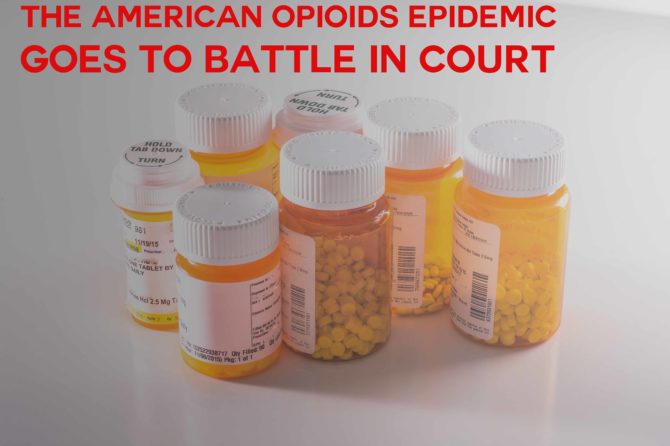
The American Opioids Epidemic Goes To Battle in Court
The country knows how tragic and all-consuming the opioids epidemic has become. According to the Centers for Disease Control & Prevention (the CDC), opioids – including prescription opioids, heroin, and fentanyl) killed over 42,000 people in 2016 alone. This amounts to the highest annual rate of death in the US from opioids yet – but don’t think it’s all about heroin. Almost half – 40% – of all opioid overdose deaths are due to a prescription opioid.
In fact, the majority of drug overdose deaths in general – a massive 66% – include an opioid. The surge in the popularity of opioids is damning; the deaths in 2016 connected to opioid use are five times higher than they were in 1999. The CDC says that, on average, 115 people in America die each day from opioid-related overdoses.
So where are people getting their hands on the drug? Astonishingly, from Doctor’s offices. The CDC weighs in, showing how the number of prescription opioids sold to doctor’s offices, hospitals, and pharmacies almost quadrupled in a decade, from 1999-2010 and deaths from prescription opioids – including oxycodone, hydrocodone, and Buprenorphine/Naltrexone, have also quadrupled from 1999.
As well as the tragic and senseless loss of human life, this is taking its financial toll too; the White House Council of Economic Advisors have estimated that, in 2015 alone, the cost associated with it top $500 billion.
So where does that leave us? Sadly, and increasingly, alone; and if we don’t do something about this ourselves, nothing will change. According to a CBS News report, the country’s drug manufacturers agree there’s a problem but say that blaming them for the crisis is senseless – or, in the words of one drug maker a “stunning oversimplification.”
That’s why the opioids epidemic has finally moved to America’s courtrooms. Mike Moore, a self-styled “country” lawyer from Mississippi, says: “Well, you can’t sue the federal government, you can’t sue all the individuals for taking the drugs. Trying to sue all the doctors in the country wouldn’t work very well, so what I say is if there’s 100% fault out there amongst many, many players, at least go to the people who made the billions of dollars on this.”
More and more people are taking a leaf from Moore’s book, and litigation seems to be the way forward – with literally hundreds of both city and county lawsuits being filed. Cases brought by 15 states are promising to force the drug manufacturers to the table to negotiate.
The basic thinking is that by suing, states can recoup some of the money lost on fighting the epidemic. According to Statnews, a lawsuit in Erie County, N.Y., alleges that Purdue Pharma, Johnson & Johnson’s Janssen unit, Teva Pharmaceuticals, and Endo International all pushed opioid prescriptions even though they knew of the dangers of addiction which, in turn, have cost the county millions of dollars each year.
It gets worse. City officials in Everett, Washington are trying a different legal tack, saying Purdue Pharma diverted its painkiller OxyContin to the black market using drug rings and pill mills.
Other underhanded tactics are allegedly being employed by an influential nonprofit called the Joint Commission. A class-action lawsuit in West Virginia against them states that the Joint Commission has spread “misinformation” about the dangers of opioid addiction for over 15 years, using content that was underwritten by opioid manufacturers. And remember, the Joint Commission is responsible for accrediting over 20,000 health organizations across the country.
It doesn’t stop there. The Cherokee Nation is suing drug companies and retailers, ranging from CVS Health to Walgreens, alleging they haven’t done nearly enough to prevent prescription opioids overtaking their community.
Over 3,000 people have died of opioid overdoses in Baltimore since 2007 and 523 of those were between January and September of 2017 alone. That’s why earlier this year, Baltimore’s law department filed a lawsuit against opioid manufacturers and distributors over the marketing of addictive pain pills.
So what can we do while these cases wend their way through the court systems? We can start by treating the problem at the source and educating ourselves as to how opioid addiction is born in the first place. Says Ohio’s Attorney General Mike DeWine, “we believe that 80% of the people who are addicts today, 80% of the people we’ve lost in Ohio, started with pain meds.”
Rehab is often a great solution to a terrible problem. Educate the addict – be it yourself or a loved one – to the facts that over time, prolonged consumption can affect a person’s ability to control themselves.
As opioid deaths make headlines – both Tom Petty and Prince’s deaths are attributed to fentanyl – public awareness of this huge and tragic problem is growing, just as the court cases are. And just as the lawsuits decades ago that took on Big Tobacco helped lead to fewer people dying of smoking-related diseases, the idea is that these current lawsuits will curb future deaths.
In the meantime, arm yourself with as much information as you can as to why opioids are a bad choice for pain mitigation – and that if you must take them, be very aware of the dangers.
Leave a reply